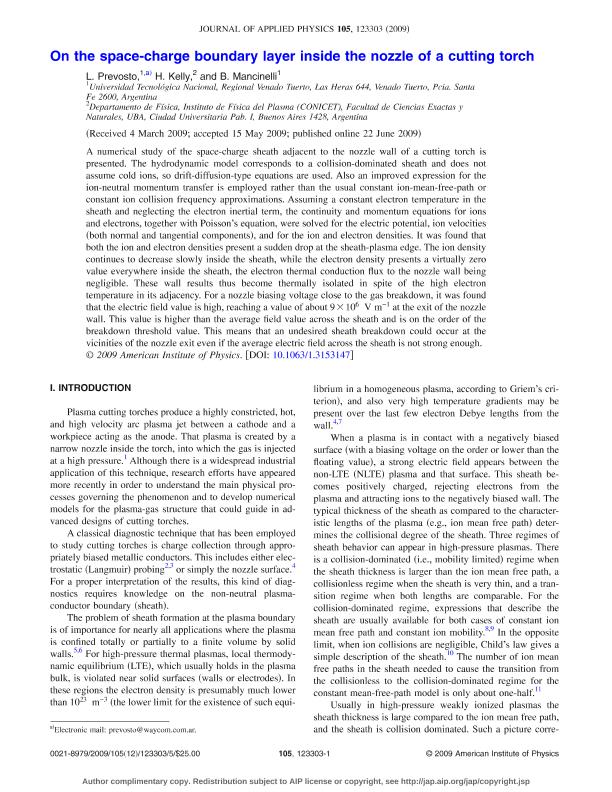Mostrar el registro sencillo del ítem
dc.contributor.author
Prevosto, Leandro

dc.contributor.author
Kelly, Hector Juan

dc.contributor.author
Mancinelli, Beatriz Rosa

dc.date.available
2018-10-02T15:25:52Z
dc.date.issued
2009-12
dc.identifier.citation
Prevosto, Leandro; Kelly, Hector Juan; Mancinelli, Beatriz Rosa; On the space-charge boundary layer inside the nozzle of a cutting torch; American Institute of Physics; Journal of Applied Physics; 105; 12; 12-2009; 123303-123308
dc.identifier.issn
0021-8979
dc.identifier.uri
http://hdl.handle.net/11336/61509
dc.description.abstract
A numerical study of the space-charge sheath adjacent to the nozzle wall of a cutting torch is presented. The hydrodynamic model corresponds to a collision-dominated sheath and does not assume cold ions, so drift-diffusion-type equations are used. Also an improved expression for the ion-neutral momentum transfer is employed rather than the usual constant ion-mean-free-path or constant ion collision frequency approximations. Assuming a constant electron temperature in the sheath and neglecting the electron inertial term, the continuity and momentum equations for ions and electrons, together with Poisson's equation, were solved for the electric potential, ion velocities (both normal and tangential components), and for the ion and electron densities. It was found that both the ion and electron densities present a sudden drop at the sheath-plasma edge. The ion density continues to decrease slowly inside the sheath, while the electron density presents a virtually zero value everywhere inside the sheath, the electron thermal conduction flux to the nozzle wall being negligible. These wall results thus become thermally isolated in spite of the high electron temperature in its adjacency. For a nozzle biasing voltage close to the gas breakdown, it was found that the electric field value is high, reaching a value of about 9× 106 V m-1 at the exit of the nozzle wall. This value is higher than the average field value across the sheath and is on the order of the breakdown threshold value. This means that an undesired sheath breakdown could occur at the vicinities of the nozzle exit even if the average electric field across the sheath is not strong enough. © 2009 American Institute of Physics.
dc.format
application/pdf
dc.language.iso
eng
dc.publisher
American Institute of Physics

dc.rights
info:eu-repo/semantics/openAccess
dc.rights.uri
https://creativecommons.org/licenses/by-nc-sa/2.5/ar/
dc.subject
Boundary Layer
dc.subject
Nozzle
dc.subject
Cutting Torch
dc.subject.classification
Astronomía

dc.subject.classification
Ciencias Físicas

dc.subject.classification
CIENCIAS NATURALES Y EXACTAS

dc.title
On the space-charge boundary layer inside the nozzle of a cutting torch
dc.type
info:eu-repo/semantics/article
dc.type
info:ar-repo/semantics/artículo
dc.type
info:eu-repo/semantics/publishedVersion
dc.date.updated
2018-10-01T15:55:05Z
dc.journal.volume
105
dc.journal.number
12
dc.journal.pagination
123303-123308
dc.journal.pais
Estados Unidos

dc.journal.ciudad
Nueva York
dc.description.fil
Fil: Prevosto, Leandro. Universidad Tecnológica Nacional. Facultad Regional Venado Tuerto; Argentina. Consejo Nacional de Investigaciones Científicas y Técnicas; Argentina. Consejo Nacional de Investigaciones Científicas y Técnicas. Oficina de Coordinación Administrativa Ciudad Universitaria. Instituto de Física del Plasma. Universidad de Buenos Aires. Facultad de Ciencias Exactas y Naturales. Instituto de Física del Plasma; Argentina
dc.description.fil
Fil: Kelly, Hector Juan. Consejo Nacional de Investigaciones Científicas y Técnicas; Argentina. Universidad de Buenos Aires. Facultad de Ciencias Exactas y Naturales; Argentina. Consejo Nacional de Investigaciones Científicas y Técnicas. Oficina de Coordinación Administrativa Ciudad Universitaria. Instituto de Física del Plasma. Universidad de Buenos Aires. Facultad de Ciencias Exactas y Naturales. Instituto de Física del Plasma; Argentina
dc.description.fil
Fil: Mancinelli, Beatriz Rosa. Universidad Tecnológica Nacional. Facultad Regional Venado Tuerto; Argentina
dc.journal.title
Journal of Applied Physics

dc.relation.alternativeid
info:eu-repo/semantics/altIdentifier/doi/http://dx.doi.org/10.1063/1.3153147
Archivos asociados
